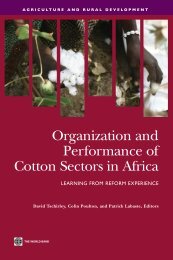Constraints to smallholders participation in Cassava value ... - aaacp
Constraints to smallholders participation in Cassava value ... - aaacp
Constraints to smallholders participation in Cassava value ... - aaacp
You also want an ePaper? Increase the reach of your titles
YUMPU automatically turns print PDFs into web optimized ePapers that Google loves.
epresentativeness. More data are needed <strong>to</strong> understand the farm<strong>in</strong>g reality <strong>in</strong> Lusaka Prov<strong>in</strong>ce andother regions of Zambia. However, the results do give valid <strong>in</strong>sights <strong>in</strong><strong>to</strong> how some people at leastbehave at the moment, and they also suggest what wider challenges - such as seed distribution,scal<strong>in</strong>g up production, local organisation - need <strong>to</strong> be addressed.One of the f<strong>in</strong>d<strong>in</strong>gs which is consistent with other research and the general state of awareness ofsmallholder farm<strong>in</strong>g <strong>in</strong> Zambia, is that production of cassava is small scale and mostly orientated<strong>to</strong>wards home consumption. While there are small economic benefits with<strong>in</strong> the sample of growersfrom entry <strong>in</strong><strong>to</strong> commercial markets, the pr<strong>in</strong>cipal benefits are improved food security. This isespecially associated with the adoption of IVs. In the case of Chongwe, NGO support and proximity<strong>to</strong> commercial outlets <strong>in</strong> Lusaka have not yet created a significant scale of commercial enterprise.The importance of this f<strong>in</strong>d<strong>in</strong>g is the <strong>in</strong>ference <strong>to</strong> be drawn, that a shift <strong>to</strong>wards a stronger marke<strong>to</strong>rientation among producers will <strong>in</strong>volve a major change of attitude and practice. Chang<strong>in</strong>gproduction patterns would not be a new phenomenon, but stimulat<strong>in</strong>g surplus production for themarket probably will require major <strong>in</strong>centives and the provision of complementary services:technical skills and <strong>in</strong>puts, managerial tra<strong>in</strong><strong>in</strong>g, bus<strong>in</strong>ess and market<strong>in</strong>g skills, f<strong>in</strong>ance, plus logisticsand communications technologies. With the current state of knowledge, it cannot be predicted withcerta<strong>in</strong>ty what will be the most effective <strong>in</strong>tervention mechanisms nor what outcomes will emergefrom chang<strong>in</strong>g the set of opportunities and constra<strong>in</strong>ts.Furthermore, predict<strong>in</strong>g grower behaviour requires caution for two reasons: firstly the sample usedhere is small, and is unlikely <strong>to</strong> be representative; and secondly, even with<strong>in</strong> this small sample, thereis a dist<strong>in</strong>ctive heterogeneity among farmers. It is surpris<strong>in</strong>g <strong>to</strong> note that – perhaps counter<strong>in</strong>tuitively- this heterogeneity is not primarily associated with socioeconomic and demographiccharacteristics and the level and thresholds of livelihood assets such as physical, natural, social,human and f<strong>in</strong>ancial capitals. Results suggest that the growers of improved varieties are like classical‘early adopters’: more <strong>in</strong>novative and more dedicated <strong>to</strong> farm<strong>in</strong>g as an occupation. Non-growers,however, are not necessarily ‘laggards’ but demonstrate characteristics of rural people who are notnecessarily committed <strong>to</strong> agriculture. For whatever reasons – and lack of labour is a contribu<strong>to</strong>ryfac<strong>to</strong>r – they are more <strong>in</strong>tegrated <strong>in</strong><strong>to</strong> an urban type of economy of paid employment, more creditand loans, lower food (maize) self-sufficiency, lower level of <strong>in</strong>volvement <strong>in</strong> community andmarket<strong>in</strong>g organisations. It is possible <strong>to</strong> <strong>in</strong>fer that structural characteristics and barriers <strong>to</strong> entryseem <strong>to</strong> be relatively unimportant: assets and thresholds play a m<strong>in</strong>or role compared <strong>to</strong> questions of<strong>in</strong>dividual attitudes and personal or family orientation. Further research is necessary <strong>to</strong> understandthe phenomenon of rural heterogeneity before appropriate <strong>in</strong>tervention target<strong>in</strong>g is possible.Manyokola is susceptible <strong>to</strong> cassava mosaic virus. It is not one of the major IVs from the ZambianRoot and Tuber Improvement Programme but orig<strong>in</strong>ated <strong>in</strong> Malawi and has been dissem<strong>in</strong>ated fromfarmer <strong>to</strong> farmer and through food security and diversification projects by JICA. However it ispopular because of its early maturity, low cyanide content and ease of consumption <strong>in</strong> fresh form.Access <strong>to</strong> plant<strong>in</strong>g materials of the right variety is a critical fac<strong>to</strong>r, and production and distribution ofplant<strong>in</strong>g materials is a serious weakness <strong>in</strong> the exist<strong>in</strong>g system. This is accompanied, accord<strong>in</strong>g <strong>to</strong>respondents, by a lack of know-how and technical capacity <strong>to</strong> grow and process cassava – someth<strong>in</strong>gnot generalisable, but which may be typical of the ‘maize belt’ <strong>in</strong> Zambia; and also by a lack oforganisational skills.17
















